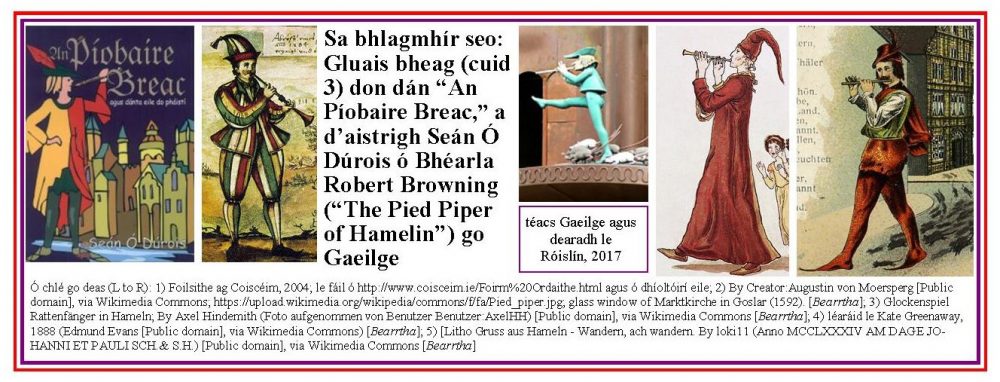How to say ‘rat’ in Irish and a continuation of the glossary for ‘An Píobaire Breac’ (an t-aistriúchán le Seán Ó Dúrois) (Cuid 3) Posted by róislín on Sep 30, 2017 in Irish Language
(le Róislín)
Bhuel, the Christmas carol, “Dhá Lá Dhéag na Nollag” may refer to “aon phíobaire dhéag,” but I could only come up with five pipers (cúigear píobairí) so far for the graphic for this blogpost. Nevertheless, it’s interesting to see the different styles of illustration and different approaches to his “pied-ness” — is it simply striped, speckled, or does he have two broad bands of color à la Lokai and Bele of Star Trek (“Let That Be Your Last Battlefield”). Of course, their episode, featuring the colors black and white, had a special significance for the Civil Rights era, during which the show first aired.
But then, the Pied Piper of Hamelin has a much deeper meaning than many children probably realize, dealing with the issues of integrity (paying the piper what you said you would pay him), disability (the one lame child who can’t keep up with the others and is “saved”), and the general idea that, in the face of disaster, we need to help each other, and not just come up with the quickest, short-term solution. Did anyone ever consider why the rats (na francaigh) had come to Hamelin to begin with? Was there too much garbage on the streets?
Anyway, the graphics above are fun to look at. I also note, in passing, one very contemporary version of the Pied Piper story, by one of my new favorite authors (ever since I read his Un Lun Dun), China Miéville, who spun a full novel out of the story, called King Rat (1998). Maybe every generation gets a retelling of the Pied Piper that reflects its own issues and values.
At any rate, back to vocabulary, starting with Stanza 11, continuing from the recent blogposts for “An Píobaire Breac” :
Stanza 11: gheobhaidh [YOH-ee is a fairly standard pronunciation and you may hear “YUFF-ee” or others], meaning “will get.” Pretty much hammered into the heads of reasonably advanced beginners, but still one of the strangest-looking words in Irish, IMO. Indispensible, though.
Stanza 11: faic, nothing
Stanza 12: raic, commotion
Stanza 13: ina mbuíonta, in their groups/hordes, from “buíon”
Stanza 13: de dhíonta, from roofs (great rhyme with “mbuíonta“!)
Stanza 14: bádh, was drowned / were drowned
Stanza 14: sa táin, among the famous people, idiomatic expression for “famous”
Stanza 14: an seanluch cróga, the brave old rat (although in theory it could be “the brave old mouse,” as we’ve recently been discussing). Usually grammatically feminine, but here, masculine.
Stanza 14: cumhra, fragrant
Stanza 14: ar maos, steeping, saturated (lit. “on saturation”)
Stanza 14: garg, acrid, bitter, sour (here re: vinegar)
Stanza 14: leamh, insipid, dull (bland re: food)
Stanza 14: maróg, pudding
Bhuel, blagmhír amháin eile a dhéanfaidh cúis, sílim. Amazing how a seemingly small project expands Malthusianly. Somehow it seems like almost every word has infinite varieties in infinite combinations (sound familiar?). At any rate, please stay tuned for Cuid a Ceathair (4). SGF — Róislín
Naisc: How to say ‘rat’ in Irish and a preliminary glossary for reading ‘An Píobaire Breac’ (an t-aistriúchán le Seán Ó Dúrois) (Cuid 1 as 4) Posted by róislín on Sep 23, 2017 in Irish Language
How to say ‘rat’ in Irish and a continuation of the glossary for ‘An Píobaire Breac’ (an t-aistriúchán le Seán Ó Dúrois) (Cuid 2)Posted by róislín on Sep 25, 2017 in Irish Language
Whose beret? Bairéad an fhrancaigh nó bairéad an Fhrancaigh? Nó bairéad an phúdail? (Showing possession in Irish) Posted by róislín on Sep 28, 2017 in Irish Language
Eolas foilseacháin: Ó Dúrois, Seán. An Píobaire Breac agus dánta eile do pháistí. Binn Éadair, Baile Átha Cliath, 2004. Gan ISBN sa chóip atá agamsa. I measc áiteanna eile tá an leabhar ar fáil ó https://www.cic.ie/books/published-books/an-piobaire-breac-danta-eile-do-phaisti-leabhair-cloite agus https://www.litriocht.com/product/an-piobaire-breac-agus-danta-eile-do-phaisti/ agus http://www.coisceim.ie/2004.html

Build vocabulary, practice pronunciation, and more with Transparent Language Online. Available anytime, anywhere, on any device.





Leave a comment: